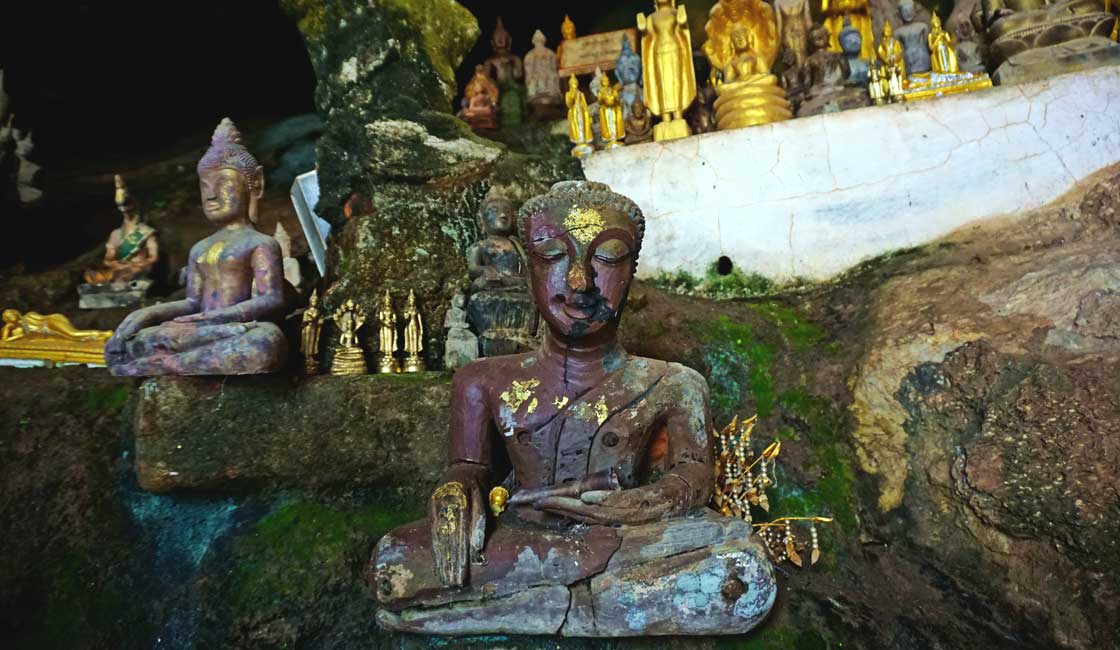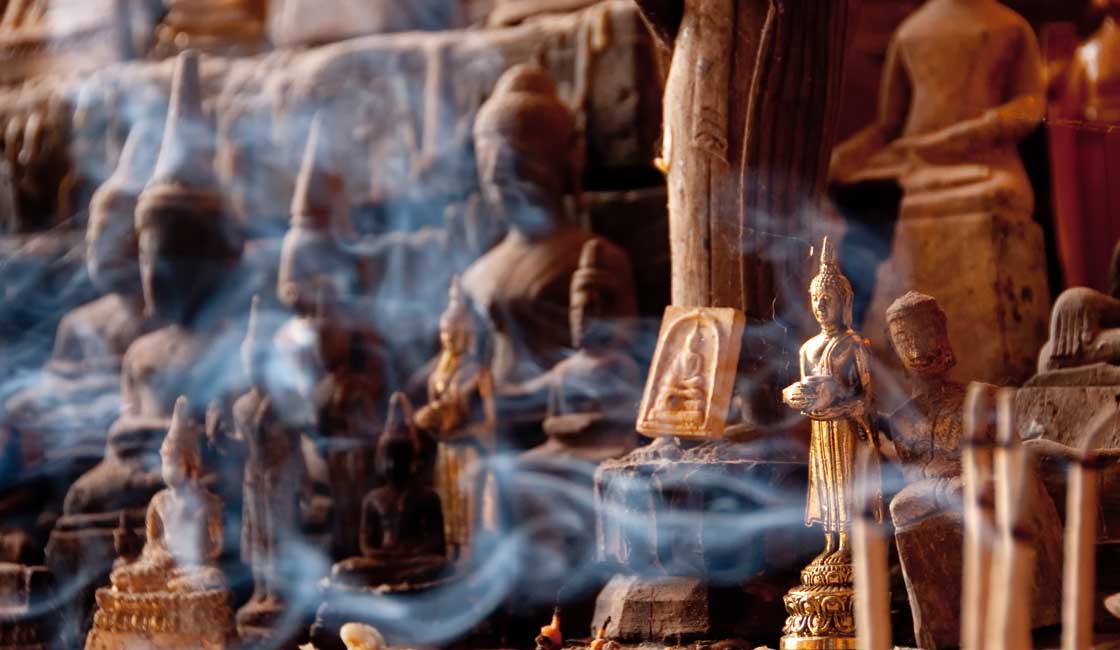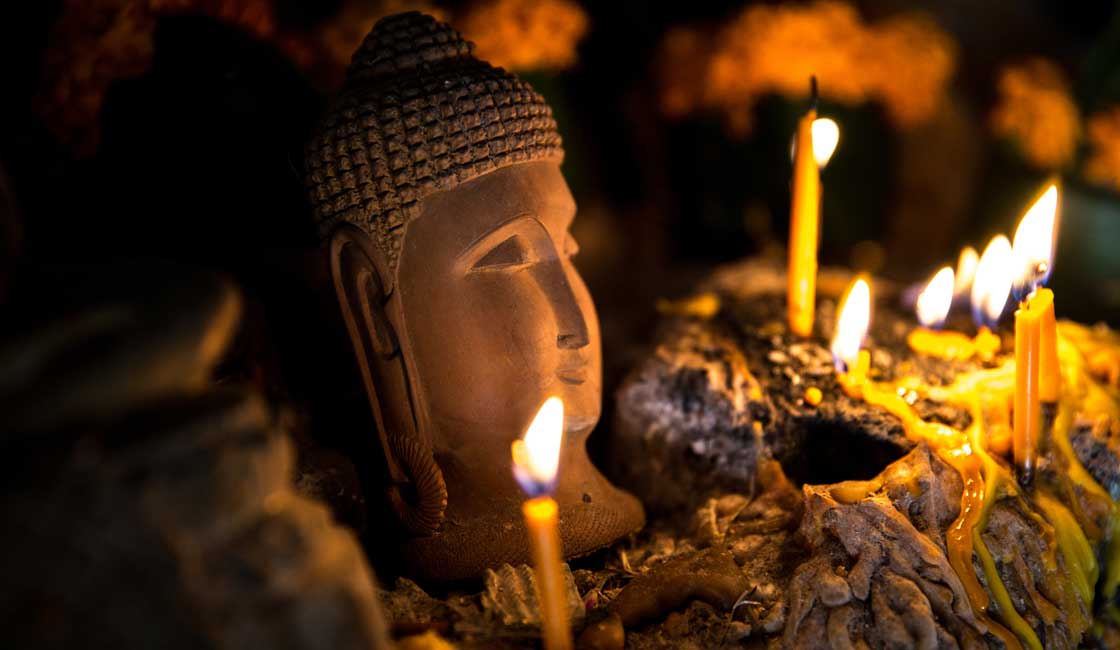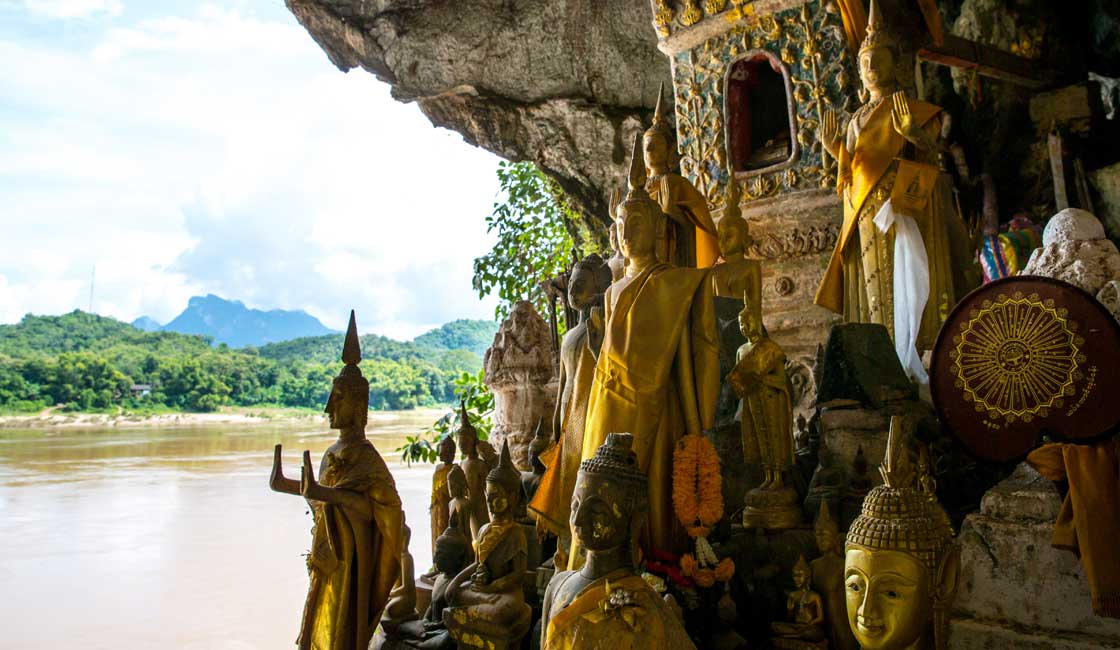
We can picture the scene. You’ve heard enough people rave about the mystical caves north of Luang Prabang, Laos, that are stuffed to the brim with thousands of Buddha statues. You’ve also read your fair share of people that think they’re overrated. Who do you believe? Don’t worry – you’re currently experiencing stage two of the official adventure-planning process. Stage one is in the bag (endlessly drooling over google images of Mekong cruises and limestone cliffs).
Now you’ve moved onto the nitty-gritty details. You’re tearing your hair out over a plethora of search engine tabs all giving you garbled opinions and contradictory advice. Should you do a day tour by boat, or take a tuk-tuk by road? Why are there so many Buddha statues? What should you take with you? And should you even go at all? All you want is to find a one-stop guide to visiting the Pak Ou caves of Tham Ting and Tham Theung.
Luckily for you, this is the last tab you’ll need to open. In this post, we’ll give you everything you need to know in one fell swoop. Read on for the where, what, why and how of visiting this iconic cultural Laos landmark.

Countless statues
The Pak Ou caves are a collection of two natural caves – Tham Ting and Tham Theung – that sit on the western bank of the Mekong. The site is made all the more impressive by its spectacular setting – at the exact point where the Mekong River and the Nam Ou river meet. The caves are named after the village of Ban Pak Ou which is visible in the distance on the other side of this river confluence.
They’re located 25 kilometers (15.5 miles) to the north of the famous town of Luang Prabang, a UNESCO World Heritage Site and a popular destination for travelers who want to observe the Tak Bat alms giving ceremony, or visit the surrounding area.
But these two rock formations are not just any old caves. For one thing, the natural cliff structure itself is pretty astonishing. The caves could be likened to jagged teeth, to crumbling sandcastle walls, even to cracked icing on a cake. They are set into a steep, vertical limestone cliff-face that seems to melt like candle wax over the enticing cave entrance, daring you to come closer. Most people visit the place by boat, and as you draw round the bend in the river, there’s no missing this remarkable sight.
Of course, it’s not really for the geological interest that so many people are attracted to the Pak Ou caves. Inside, they are home to one of the world’s most incredible collections of Buddha images – in the form of statues, models and pictures. There are an estimated 5,000 statues in total, all of different shapes and sizes, dating back to the 16th century.
The first cave is the one lower down, closest to the river, and most easily accessed. This is Tham Ting – in this cave you’ll find many more tourists and an amazing collection of ornate models of the Buddha. Visibility is good in Tham Ting as it is a much smaller cave and gets plenty of daylight for viewing the statues. You’ll get some striking photos of the statues silhouetted against the view of the river from this lower cave.
Be prepared to work a little harder to get to the second cave! Tham Theung (sometimes known as Tham Phum) is found about 60 meters (197 feet) above the river level, and is a much deeper cave, stretching a good 50 meters (164 feet) into the cliff. It takes about five minutes to climb up to this one, by following a steep but well-established series of steps. On the way up you’ll find various vendors hawking their wares – things like incense sticks and candles to use to worship in the caves. The entryway to Tham Theung is furnished with a large and beautiful set of wooden doors.
It’s well worth the climb – you’ll find this cave less crowded (lots of people don’t bother coming up here would you believe!) and it actually holds the majority of the artifacts. Every single surface is crammed full of ornaments, giving it a weird combination of temple-meets-gift-shop! It gets very dark in Tham Theung so make sure you bring a flashlight to see the cave contents!

Burn your incense
So how did this special place come into being? Well, we can only guess at the origins of the caves themselves but their fascinating history as a holy site dates back thousands of years, of which Buddhism is only a small and fairly recent part.
Long ago, the Pak Ou caves were places of worship dedicated to river spirits and the gods of nature. These temples were visited and revered by one of Laos’s indigenous ethnic groups, the Khmu people.
It is only in the last five hundred years that the caves have become sacred Buddhist sites. Legend has it that they were discovered by King Setthathirath in the 16th century, a great Lao ruler remembered for constructing the Buddhist temples of Pha That Luang in Vientiane, and Wat Xieng Thong in Luang Prabang. This was around the time when Buddhism was rising to become the dominant religion in the Lan Xang Kingdom. All across Luang Prabang province old animist shrines like the ones at the Pak Ou caves were being destroyed and converted into Buddhist temples.
From the 16th century until 1975 (when the last king of Luang Prabang was deposed after the communist revolution) there has been an annual Buddhist tradition held by the monarchs of Luang Prabang at Pak Ou caves. The king would visit these spiritual caves at Laotian New Year, and a traditional washing ceremony would take place. New Buddha statues would be cleansed in a large and long ceremonial wooden washing station shaped like a dragon, which is still there in the entrance to Tham Theung, the upper cave.
These royal pilgrimages to the caves meant that they were well-kept and in good condition, but this responsibility was taken up again in 1992. A huge conservation effort was launched as a collaborative project between Laos’s culture department and the Australia’s University of Canberra. This took five years and included rebuilding and safeguarding some of the infrastructures, training up local staff members, putting up signs, and of course, conserving some of the ancient Buddha images and statues.
Although the site has been recently discovered by travelers from all over the world, it’s not just tourists come to this magical place. The caves are very much still an active place of worship, and you’ll most likely see local villagers and pilgrims burning incense and offering prayers at the shrines in the lower cave. Traveling to Laos does mean many opportunities to observe Budhist ritual.
Every April at Lao New Year, locals head to this significant spot to offer prayers at the altars and bring their own Buddha images. Some of them they leave behind to become immortalized as part of the collection, and some of them they just bring to wash in the holy water in the special statue-washing font in the hope of earning merit for the following year.

Buddhas
No, it is not a silly question! The sheer quantity of Buddha statues really has to be seen to be believed. Thousands upon thousands of these objects have accumulated over hundreds of years and now adorn every possible nook, cranny, shelf, and surface. The statues really are the stars of the show here, and so it’s a great opportunity to really study them while you’re inside the caves, or get some good photographs to go through at a later date.
The variety is what makes the site so bizarre and wonderful – this is what lures visitors from all over the world. There is a complete range of types, sizes, and materials. It’s not even just Lao Buddhism on show here, but some examples of Thai and Chinese Buddhism too. Many of the sculptures are made from wood and range from a few centimeters to several meters in height. Some, however, are made from bronze, animal horn, ceramic, resin, stone, and even emerald. Many are painted in red or black lacquer, and some are even decorated with gold leaf. The figurines assume a range of different poses or mudras. From raising their hands in peace, reclining (the nirvana Buddha), calling for rain, teaching to simply meditating.
Some are ridiculously lavish and richly ornate, while some sculptures are basic and crude. In fact, what links all of these miniature figures are their tiny imperfections. All of these statues are ‘retired’ – they’ve been brought here rather than being abandoned or discarded, in order to retain a sense of respect. Many have visible chips and signs of wear and tear – missing hands, chipped faces, worn-down bellies – while some of them are heavily damaged. It’s also a sad truth that termites make their way through a large amount! If you ask us, it’s these little idiosyncrasies that make the collection so unique.
It’s hard to guess how many there actually are in total but current estimates number at over 5,000. The reason there is such a high number is due to the hundreds of years of royal patronage by the Luang Prabang monarchy, who used to commission artists to make sculptures and icons to place here. As well as this, a large proportion of them has been donated by pilgrims and locals, building up over the centuries.
According to a recent study, as well as the myriad of Buddha statues, there are some amazing examples of cave paintings and other rock art elements in Tham Theung and along that stretch of the cliff face. Excitingly, these are mostly red paintings of human figures, bears, buffalos, and handprints akin to other ancient examples that have been found elsewhere in Southeast Asia.

Right by the Mekong
If you’re heading to the Pak Ou caves you’re more than likely to be coming from the town of Luang Prabang, and if you haven’t factored in a visit there, you’ll have to pass through there from most places anyway. You can get to Pak Ou caves from Luang Prabang by boat or by road. The caves are open every day between 8 am and 5 pm.
We believe that arriving by water is the best way to see the caves (but then we are rather fans of Mekong River cruises!), and the majority of people choose to travel by boat. Water is such an important part of the site, that catching your first glimpse of the two caves as your boat turns round the bend in the river makes the experience truly unparalleled.
There’s no denying that if you go by water, the journey to the caves is as big a part of this trip as the destination itself. As the boat rumbles softly up the river from Luang Prabang you get an extraordinary insight into an uncensored version of rural Laos, far away from all signs of hectic modern life. The Mekong cuts through jaw-dropping scenery, with no telephone wires or bridges to impede the view, the curving river stretching for miles against the distant backdrop of the limestone mountains.
Sit back and enjoy a roughly two-hour upstream journey (the journey back downstream takes just over an hour), as on the river banks a unique montage of Laotian daily life plays out. Children play and splash in the shallows, buffalo herds drink at the water’s edge, and village huts can be glimpsed through trees. Buddhist monks with their bright yellow robes pass each other on remote dusty paths, and families wash themselves and their clothes. As the legendary caves of Pak Ou eventually come into sight, it’s not hard to imagine what it must have been like for the royal pilgrims of the 1500s to make their spiritual journey of devotion.
Tickets cost 75,000 kip (around 8.5 USD) for the return boat trip but this does not include entry to the caves themselves which is an additional 20,000 kip (2.2 USD). It generally takes about half a day there and back, allowing for around 50 minutes at the caves themselves although this can vary so it’s a good idea to check when you book. Many people decide to squeeze in a trip to see Kuang Si Waterfalls in the afternoon (although if you can, a full day at the waterfalls is a better option).
You can get boat tickets for a day trip to the caves from the longboat office in Luang Prabang – make sure you book in advance. The boats leave every morning at 8:30 am from the pier near Saffron Café, and you’ll be given full instructions when you buy your tickets (sometimes a pick-up service can be arranged from your hotel for example).
The tours do vary so it’s worth finding out exactly what trip you’ve booked onto. Some tours include a short cruise up the Nam Ou river or even a trip to the aforementioned Kuang Si Falls, so make sure you know what you’re paying for. If you’re feeling flush or are traveling with a group, it is possible to charter a private boat for somewhere around 300,000 kip (around 34 USD) which gives you greater freedom for the day.
The option of traveling by road is more expensive and not as popular but it is a bit quicker and can give a bit more freedom so far as timings. You can charter a tuk-tuk, minivan or taxi to the village across the river from the caves called Ban Pak Ou. From here, you’ll have to cross the river by a short boat journey to reach the site itself.
The cost of hiring a tuk-tuk and driver is around 200,000 kip (22.4 USD), and the short river crossing costs 10,000 kip (just over 1 USD) each way. This, of course, doesn’t include the 20,000 kip (2.2 USD) entrance fee. The round trip is about 30km by road, which should take about an hour each way (not including the boat crossing). Be prepared for the road to be very bumpy!
Most of the boat tours incorporate a stop along the way at a small artisan village – the ‘Lao Lao Village’ of Ban Xang Hay or the village of Ban Xang Khong that is famous for mulberry leaf paper and silk weaving. Lao Lao is a famous Laotian rice whiskey that is produced in this region and will be in ample supply at the village – sold in dubious-looking bottles stuffed with dead amphibians.
Although these side trips are basically tourist traps, the villages themselves are full of charm and you do get the chance to sample the local wine, whiskey, and other wares (even if 11 am in the morning seems a bit early for this!). The villagers are warm and friendly, and the buildings are quaint and photogenic. You might find that the tour includes lunch at one of the local restaurants. There are plenty of stalls with typical souvenirs, and the streets are filled with colorful weavers’ looms and fabrics.

The calm Mekong
In our book, visiting the Pak Ou caves is up there with the top things to do in Luang Prabang. With the thousands of statues in the Pak Ou caves, it’s about appreciating the tiny details that make the experience so unforgettable.
Now you’ve read this guide you know exactly what to expect and you’ll be able to fully immerse yourself in the experience. You know all about the fascinating history of this holy site, and the reason behind all the statues. Everyone notices something different on their trip to the Pak Ou Caves – what small details will stick in your mind we wonder? If you want to find out more, and how you can incorporate a visit to the upper and lower caves of Pak Ou on your trip to Laos and Southeast Asia.
While Rainforest Cruises aim to provide accurate and up-to-date information, we make no representations as to the accuracy or completeness of any information herein or found by following any link on this site. Rainforest Cruises cannot and will not accept responsibility for any omissions or inaccuracies, or for any consequences arising therefrom, including any losses, injuries, or damages resulting from the display or use of this information.




